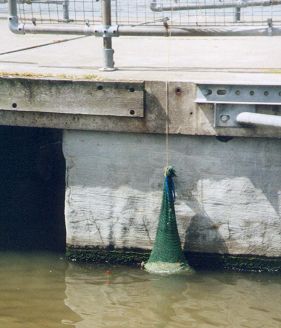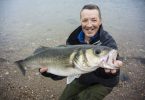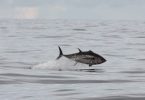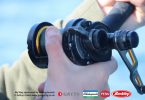Using a Bread Bag for Mullet – Science, Art or Philosophy?
An experienced eye can pick an expert mullet angler out from quite a distance.
Usually fishing apart from other anglers and fishing in a totally different way. The real evidence is the landing net and the long thin rod. Other signs might include the unhooking mat, the Polaroid glasses, the funny hat and the small slim float.
But put the same angler on a riverbank and there would probably be nothing to distinguish a mullet angler from a chub angler.
Nothing that is, apart from the bread bag.
That one piece of equipment is the give away that separates many mullet anglers from all other disciplines and species specialists. A tell-tale sign that screams ‘mullet man!’
Certainly for most mullet anglers fishing close in, from docks, piers and pontoons, the humble bread bag is regarded as one of the most essential pieces of equipment.
At its most basic level, the bread bag is a net, filled with bread, sending a stream of bread particles into the flow of the tide, attracting mullet educated to bread toward the fishing area within range of the angler.
Yet I’ve seen all kinds of nets, loaded differently, set at different depths.
Whilst it’s true that the experienced bread bag user has a repertoire of tactics available for different situations and conditions, it’s more usual that the angler concerned has not really thought through what they are trying to achieve, or how best to go about it. They use the most readily available netting, stick in some bread, and perhaps a stone to weight the sack, lower the sack into the water and hope for the best.
Yes that does work, but not as well as it might.
So, let’s look first at the basic set up, and at some alternatives.
Firstly the net itself.
In my opinion, there is no finer bread bag netting than the green net bags in which the winter vegetables arrive at the greengrocers. Usually brussel-sprouts, often swedes and beetroot too (but they usually come in different coloured netting, perhaps orange or mauve). The colour doesn’t matter at all, but the soft multi-strand mesh is the kind to look for.
Although you’ll often read old advice to use an onion sack, most of today’s orange onion sacks have too stiff a mesh to be efficient for use as a bread bag; they are rather on the ‘too big’ side as well. Also to be avoided are the nets made of stiff, single strand, plastic mesh. Again these are not very efficient at generating a steady stream of bread particles into the tidal flow.
Now the ceremony of the mashing of the bread.
I prefer to mash my bread in a bucket, before filling the net. Two or three loaves will usually do.
Fill a two-gallon bucket about a third full with seawater, and then add the bread, squeezing it between your fingers to reduce it to a mash. (Is there a better feeling than that of squishing wet bread between your fingers on a hot summer day? It even beats walking barefoot out across soft mud, toward an approaching tide, the soft mud squishing up smellingly between your toes!)
It’s usually at this point that the kids arrive from further down the pier to see what you are up to, recoiling in disgust at the site of hands buried up to their wrists in a mixture resembling something they had last seen when they were once very ill!
Once the mixture has reached a lumpy, creamy texture (I’m writing a cookery book next!), now is the time to add your own secret additive.
Again this isn’t necessary, and I’m not sure that it makes much difference, but I know mulleteers who gain confidence by adding a tin of sardines, maybe a few drops of Marine Crustacean Extract, or any of the more exotic flavourings now on the market (perhaps also forgotten winter pike deadbaits, dug from the bottom of the freezer and whizzed around in the liquidiser). I’m told that the Danes marinate their mash overnight in diesel oil!
Now tip the mixture into the net (carefully!).
It’s best to do this close to the water’s edge so that the creamy white run-off runs into the water to form its own mullet attracting cloud, rather than drying into an unattractive pool of mashed bread debris to the annoyance of other users of the pier or dock.
I usually keep some of the mixture back in the bucket. Some of this is used to fill my swim-feeder, when I’m using a swim-feeder rig on my second rod. Some can be fed directly into the water (preferably using a long-handled kitchen spoon), when the tide is slack and the day too calm to rustle up a breeze to generate wavelets to gently rock the bread sack and keep it working.
(It’s usually at this point in the proceedings that I discover that, once again, I’ve left my hand towel in the dryer, back at home!)
Using a cheap ball of garden string, I tie this to the neck of the sack and lower it to the water, securing the sack to a handrail, or other semi-immoveable object (such as my tackle box), and cutting the string to the length required (remember that if you are fishing a retreating tide from a wall or similar, to leave enough length to continue lowering the bag, following the tide down.
An alternative method of mashing bread (useful if you’ve forgotten your mashing bucket perhaps) is to put the bread into the sack, lower it into the water and swish it around to get the bread wet then pull it ashore and stomp all over it.
This method particularly appeals to those strange folk who really don’t like the satisfying sensation of squishing handfuls of wet bread through their fingers, but try as you may, you won’t get such a good discharge of particles from this method as from bucket hand-mashed bread.
(Though during a lengthy session, it’s sometimes necessary to lift the sack, when most of the finer particles have been washed out and to give it a good squishing using the method of your choice).
Positioning the sack.
I prefer to lower the sack to the waterline, with just a little of the mixture above the waterline.
The weight of the mixture above the waterline pressing down gently on the mixture belo
w, slowly forcing it through the mesh and into the tide.
The rate at which the bag empties depends on the conditions.

A chop on the water will rock the net and lap at the mesh, emptying it quite quickly (but it should last most of the session). The wake from a passing boat can swish the whole net around releasing a sudden cloud of bread particles into the flow.
If the net is working well, and with a reasonable tide, you should see a satisfying stream of tiny bread particles drifting off down tide.
This is where the difference between a good sack, and others made of stiffer materials, becomes most noticeable. The bread in an ‘inefficient’ sack just sits in the sack, going nowhere, whilst the flexing of the mesh of a good vegetable bag seems almost to pump out a stream of particles.
But beware any tears that sometimes mysteriously appear in the sack. These can be made by mullet feeding below the water line, or crabs that seem to enjoy bread even more than lugworm. Even a small hole can release mashed bread at a considerable rate. Fortunately such holes are easily repaired with some fishing line and no need of a sewing needle.
It’s the criticality of the size and construction of the mesh that really amazes me. To have such good fortune in having such a perfect item of tackle as a sprout net, cheaply and readily available seems somehow mystical.
In my experience, the universe doesn’t usually work that way. It seems to be a cosmological rule that things that do the job best are usually considerably more expensive than the alternatives. Perhaps mullet fishermen are blessed in some special way!
Once everything is ready, and you are fishing, remember to keep a close eye on the sack, preferably wearing Polaroid glasses.
Other than watching a stationary float suddenly spring into unnatural life, there are few sights more thrilling (especially in the muddy Medway water I fish) than seeing the slight bounce of the net as an unseen mullet feeds on its contents from down below, or perhaps a flash of silver below the sack.
Sometimes, like a grey ghost, the outline of a mullet fades into view alongside the sack, and can clearly be seen mouthing the mash through the mesh.
With a float fished bait, close to the net, do you wait for the feeding fish to find your hook-bait, or do you move the bait, knowing that the movement of the rod overhead may spook the fish away, but also knowing that a bait lowered down next to the bag often provokes a take? Breathless moments with a decision to be made; all part of the thrill of mullet fishing.
Sometimes feeding fish, especially the wary more experienced bigger fish, will ignore the hook-bait completely, pre-occupied with feeding only from the bag. A successful tactic to deal with these fish can be to gently lift the bag out of the water, leaving the fish to search for remaining scraps, including your own hook-bait.
Jim, a member of the Medway Mullet Group, tells of a fish hanging onto a bag that he was trying to lift clear, determined to win the tug of war, and almost coming out of the water with the bag. Jim eventually won, to both their surprise.
On other occasions, we have seen feeding fish melt away, as the bag was lifted high, only to reappear as the bag was slowly lowered again, even before it was finally lowered into the water, the mullet gathered expectantly below. I get the impression that they hadn’t moved far off, just to a safe distance whilst keeping an eye on our activity.
I’m also firmly of the opinion that, where bread-bags are often used, the fish become accustomed to them and if there are fish in the vicinity, they will move toward the familiar shape of a bag hanging in the water when they first detect it, rather than simply following the trail of particles. The bag itself has become a beacon, calling them.
Depth
Though I usually prefer to position the bread bag at the surface, where I can keep a good eye on it and on what’s happening immediately around it, sometimes the fish are reluctant to come near the top.
Particularly on bright calm days, and when there is a lot of activity going on above the water.
At the end of the season too, when the water temperature starts to drop, I find that the fish prefer to feed deeper. Look for lip marks on the walls at low tide. If they are consistently down toward the bottom, then the fish may be feeding deeper. (Frustratingly, you can never be sure if it’s merely a sign that the fish have been feeding early in the tide, and have moved on as the water has deepened!)
If the fish aren’t coming to the surface to feed, then it’s worth weighting the bag (perhaps with a stone or half brick) and lowering it deeper, adjusting the depth at which you are going to fish accordingly.
But remember, the weight will be at the bottom of the sack, with all the bread floating to the top. You need to allow for that when deciding how deep to go.
Flavouring the bait
If you’ve mixed your mash in a bucket with some additive, you might feel happier if your hookbait has the same smell as the particles floating away from the bread bag, or the free offerings spooned into the water directly from the bucket.
Often, when pinching bread flake to the shank of the hook and lowering it into the water, the bait shows some unwanted buoyancy that may have it floating back up past the weights, just beneath the float. Habitually, once I’ve baited the hook, I’ll dip the dry bread and gently squeeze out the air so that it sinks more naturally below the tackle.
Now instead of dipping it directly into the sea water, try scooping some of the mash still in the bucket to one side, and letting the depression fill with the flavoured water from the mash itself, then dip your dry bait into this instead. Even if you are not using flavour or smell enhancers, the bait will absorb the creamy water from the mash, making it more attractive than bread-flake that has absorbed mere seawater (for a while at least).
Pre-baiting
This neatly needs to the next point, getting the fish interested in bread and feeding from bread bags.
Watch mullet lazily mooching about in clear shallow water. They seem to wander aimlessly about, feeding on the mud and venting small clouds of mud every now and again. Watch them for a while, and you begin to notice that whereas their wandering seems to be completely aimless, somehow there are spots that they will wander over time and again, on their seemingly aimless routes.
Particularly if you have laid out a small amount of bread, clinging to the bottom.
Coming from a coarse angling background, I’m used to the principle of baiting an area, and holding fish in that area by constantly re-baiting. The fish coming in, and feeding until it’s all gone.
It doesn’t seem to happen like that with mullet.
Though they will repeatedly return to a baited area during their meandering, feeding as they pass by, They are perfectly happy to leave the baited area, and resume their meandering, even though there is plenty of food still around.
Perhaps the reason for that is what often happens to the shoals of coarse fish, competitively feeding in a baited swim. Sooner or later, the swim goes quite and you can guess what’s happened below.
Sometimes a swirling on the surface, perhaps accompanied by an explosion of silverfish into the air, leaves you in no doubt at what’s happened below. All the fuss created by the shoal of fish, preoccupied with their feeding, has attracted the attention of a predator.
It may be that mullet, in their greater wisdom, have long ago learned not to spend too much time gathering around a rich food source. Far better to keep moving, and come back to it again and again.
After all, mullet are usually niche feeders, not competing with any other species for their usual food of algae and micro-organisms sifted from the mud, or scrapped from rock. What they don’t take on this pass will almost certainly still be available on the next pass.
And so it is with bread-bags. The mullet, on their meandering will come across the stream of particles, or detect the hanging bag, and decide to investigate the contents, but they won’t gather for long.
But once they have marked the spot, they will return. And they will return again and again.
If the bag is refilled each day, they will go out of their way to visit. Maybe as they follow the tide up and down the coast, or along the banks of a tidal river. Even if bags are only sometimes found at the spot on odd occasions, they will visit to check out the day’s situation.
(Work on conditioning bass to respond to a feeding bell show that the conditioning still works even after six months of not feeding them. Ring the bell and they will come. I reckon mullet are far more ‘intelligent’ than bass. If they know that sometimes a bag of bread mash is left at a certain spot, they will call by now and again to check it out).
So, leaving bags out is a way of getting the mullet to come and visit your fishing spot.
The trouble is that not only mullet are interested in your bread bags.
The worst problem (around my way anyway) are the feral kids. The sight of a string disappearing into the water is just too much for their curiosity and, having investigated what is below, what good fun it is to cut the string and let it drift off to join the life-belt thrown in for a laugh earlier.
The swans are as bad! If the bread bag is at all accessible they will work hard at tearing it apart, sometimes assisted by gulls, and the mud-rats that scamper across the mud at night, from their hidey-holes along the shore. And then of course there are the crabs!
String bags sometimes don’t last long, left out alone. Not unless they can be hidden below the waterline in deeper water where they won’t be exposed by a retreating tide.
I’ve found that a ‘bag’ made out of chicken wire will solve most of the problems, if it can be hidden out of sight of the feral kids.
Sometimes you may want to use a bag, a little way out, whilst fishing from the shore, rather than hung down a harbour wall.
Easy enough to wade out at low water and place the bag beneath a heavy stone. If you want the bag to float near the top, then you tie it to the stone with a length of string. This will let it float, anchored to the spot.
One problem with this is knowing exactly where the anchored bag is when it is out of sight, held to the bottom or floating some way beneath the surface. A bottle cork, held by a length of line attached to the bag, will make a good buoy, (or as the carp anglers will tell you, a marker float!). If it’s not possible to wade out, then attach the whole lot to a strong cord (‘anchor’, filled bread bag and marker buoy) and sling it out as far as you can!
But be careful where you cast your tackle, and how you play a fish. It’s so easy to end up tangled with the bread bag or anchor chord etc!
Bread bags – other uses
Fishing different methods for different species makes you wonder at how techniques and tackle used for one species can be adapted and applied to another.
A ‘bread-bag’ filled with munched up oily fish, slung over the side of a boat, or from a pier can be an effective attractor when float-fishing for gar, mackerel etc (great sport on a light outfit. Watch out for sharks though!). Attached to the anchor chain, and filled with a mixture including mashed shellfish, crabs etc., it can also send out an attractive scent trail for deeper feeding species.
Remember what I said about being able to tell the difference between a mullet angler and chub angler? Well that isn’t necessarily so. Borrowing the idea from my mullet fishing, I’ve found that a bread bag is a useful accessory when stick-float fishing the current of a river. Rather than hand-feeding balls of bread-mash, or small handfuls of maggot, that have the shoal chasing the free offerings down current and away from me, a bread bag filled with mash and maggots, suspended from an overhanging tree, bridge, or anchored in the current releases a steady flow of particles, bring the fish toward the fishing area, rather than having them chase away.
And in late summer, instead of spending valuable fishing time plaiting my home-grown onion and garlic strings for hanging, quickly stuffing them into a spare bread-bag does the job just as well!
Mullet Conservation
Mullet are a slow growing fish, in UK waters taking around 10 years to reach spawning age at around 3lbs in weight and spawning only every other year, sometimes every three years.
It will take nature another 15-20 years to replace a specimen fish of 6lb , and tagging shows that mullet are often caught several times from the same area. Venues where mullet are taken for the pot rarely produce the big fish
that serious mullet anglers crave.
If you want to be catching big fish in future years, put back the smaller fish you catch today, and remember that when you do finally land that remarkable specimen, it’s likely been caught and returned by one or more conservation minded anglers in years gone by.
For more information on mullet and fishing for them have a look at https://www.anglersnet.co.uk/Sea-Fishing-Articles/mullet_faq_one.html
Tight Lines – leon
(This article was originally published in volume 12 of ‘Grey Ghost’ (Spring 2003), the Journal of the National Mullet Club. http://www.thenationalmulletclub.org/ )








